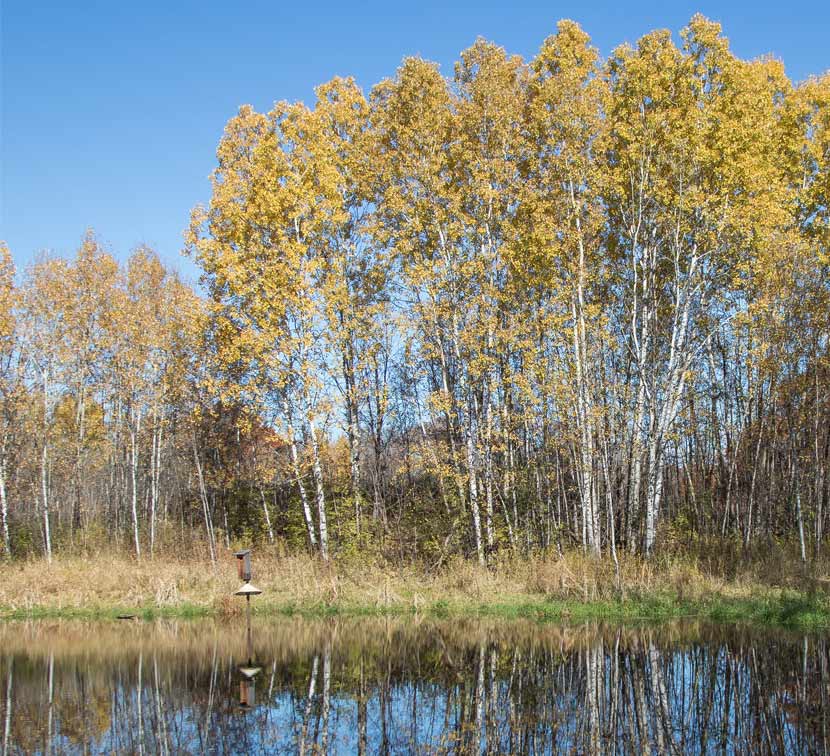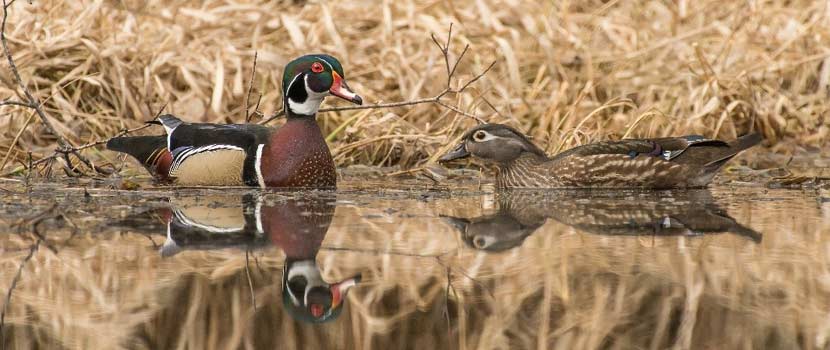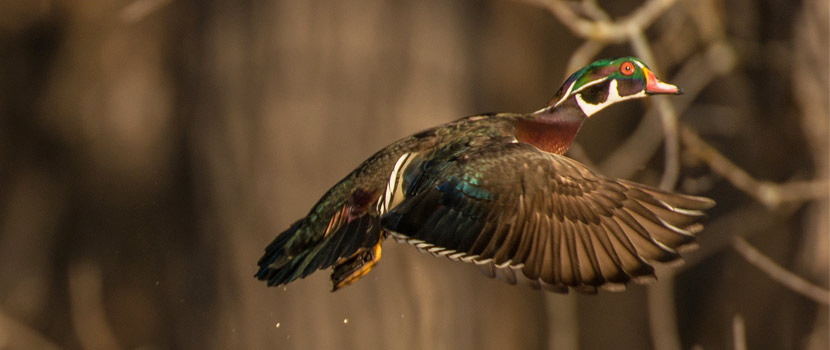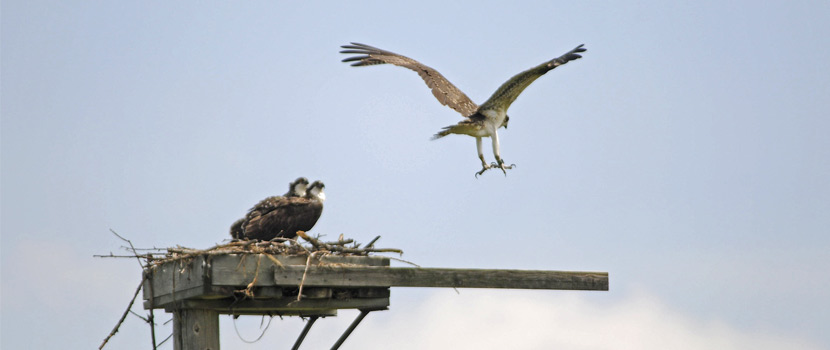
Giving Wood Ducks a Home in Three Rivers
By: Steven Hogg
October 13, 2020
Category: Resource Management
Working as a biologist for Three Rivers Park District, I often find myself in the parks as the sun starts to rise over the horizon and warm up the landscape below. It is during these times that I am met by the morning chorus of animals that awaken and greet the day with their symphony. It is not hard to be found along the edge of a waterway in Minnesota.
During these moments, I can often hear the characteristic "wheeeep wheeep wheeep" of a wood duck in the distance as it flies by greeting all who are within earshot of its morning routine. I am reminded during these memorable moments what it is that I do and why.
A Spectacular Duck

In my opinion – and along with many other biologists, hunters and bird watchers – the wood duck is the most beautiful duck in North America. The wood duck has so many colors that you may not have enough time to take all of them in when looking at them through a pair of binoculars.
What makes this species even more spectacular for us is that it is commonly found within Three Rivers parks. In fact, Minnesota is a core nesting area for them.
A Brief History of Wood Duck Management in Three Rivers
Three Rivers has a long history of wood duck management. Historic wildlife reports indicate that wood duck management has been occurring within our parks since as far back as 1968, and the management of the boxes has evolved over time.
In the beginning, wood duck boxes were placed on trees. Today, we place them on steel posts over water with a predator guard. These protocols help give wood ducks a greater chance of survival.
We use the standard wood duck boxes that can be found in Carol Henderson’s Woodworking for Wildlife. These houses were originally designed by past waterfowl managers and have been approved upon over time. Today, they are the ideal dimensions for wood ducks.

Why Are Wood Duck Boxes Important?
Wood duck nesting boxes are very important because wood ducks are dependent on tree cavities for nesting – and these cavities are in short supply. Wood ducks require old trees to have large enough cavities for them to nest in. Because the forests of our parks are relatively young, there are not many trees that offer this nesting habitat. Hopefully as we continue restoration and reforestation work in Three Rivers, we will provide more natural places for them to nest over time.

Another native duck in this area that use cavities are hooded mergansers. These ducks are easily identified by the males striking “hood” that when erected is mostly white with a black margin. These ducks are the only merganser that nest in central Minnesota utilizing the habitat in our Parks. These ducks also readily take to wood duck boxes placed in our parks.
A Volunteer Effort
We consistently maintain and monitor wood duck boxes in nine Three Rivers parks: French Regional Park, Eagle Lake Regional Park, Fish Lake Regional Park, Baker Park Reserve, Gale Woods Farm, Carver Park Reserve, Glen Lake Golf and Practice Center, Hyland Lake Park Reserve, and Elm Creek Park Reserve.
Brad Pierson, a Three Rivers volunteer, has updated and installed hundreds of wood duck boxes while following the latest box design and management protocols. Since 2013, he has been the primary volunteer responsible for the installation, maintenance and reporting of wood duck boxes.
The results discussed below are thanks to his efforts.
Have Wood Duck Boxes Been Successful?

A successful box is one that contains egg membranes when checked in the winter. We typically check boxes and clean and prepare for the next season once the ice is thick enough to walk on.
When a box is successful, it’s difficult to tell whether it was used by a merganser or a wood duck. I have found no evidence short of genetic testing to be able to distinguish between wood duck and merganser egg membranes. When we check the boxes for use, we also count the number of membranes to see how many ducks hatched.
A report from 1968 shows that of the 60 wood duck boxes that had been placed in the parks, only five of them were successful.
In 2019, we checked 115 boxes. Seventy-six boxes were successfully used – a 66% success rate. This is a great improvement over the 8% success rate in 1968.
In 2019, a total of 639 ducks hatched from boxes in Three Rivers. The average number of membranes that hatched per successful wood duck box was 8.41 – a little over eight baby wood ducks per box. This success rate seems to be on par with other well-managed wood duck box programs in Minnesota.
Over the last five years, the average success rate between the 10 parks has stayed relatively constant:
- 2018: 66.29% success rate
- 2017: 63% success rate
- 2016: 64% success rate
- 2015: 66% success rate
Where Can You See Wood Ducks?
You can see wood ducks in most, if not all, Three Rivers parks during their nesting season. Look for them in the nine parks that have nesting boxes or in any area with lakes. In the fall, wood ducks migrate to the southeastern United States, where they spend the winter.
Banner image courtesy of John Pennoyer.
About the Author

Steven Hogg is the Wildlife Supervisor at Three Rivers Park District and has been working for the Park District for 13 years. After graduating from the University of Alberta with a degree in Environmental and Conservation Biology, he moved to Minnesota to marry his beautiful Minnesota bride. Steven has always had a passion and dedication for wildlife, even when he was young. This passion is what lead him into a career where he strives for the proper orchestration of research, management, and politics to ensure natural resources and wildlife are given a voice. In his spare time, which there is little of with his three kids, Steven likes to farm, hunt, and fish.
Related Blog Posts
Believe it or not, fall bird migration is already starting! From ospreys to owls to waterfowl, read all about what birds pass through our area of Minnesota and where in Three Rivers you can expect to see them.
Reintroducing Trumpeter Swans: What It Took to Succeed
By: John Moriarty
Trumpeter swans once nested throughout Minnesota, but were eliminated by early settlers who hunted them for feathers and food. Learn what it took to restore their populations and explore current efforts in managing trumpeters today.
Osprey Reintroduction: The Great Success Story
By: Steven Hogg
Ospreys used to be very common in southern Minnesota, but they disappeared from the Twin Cities after World World II. Learn about the program to bring these amazing birds back and how wildlife can survive in an urban area when given the right tools for success.



